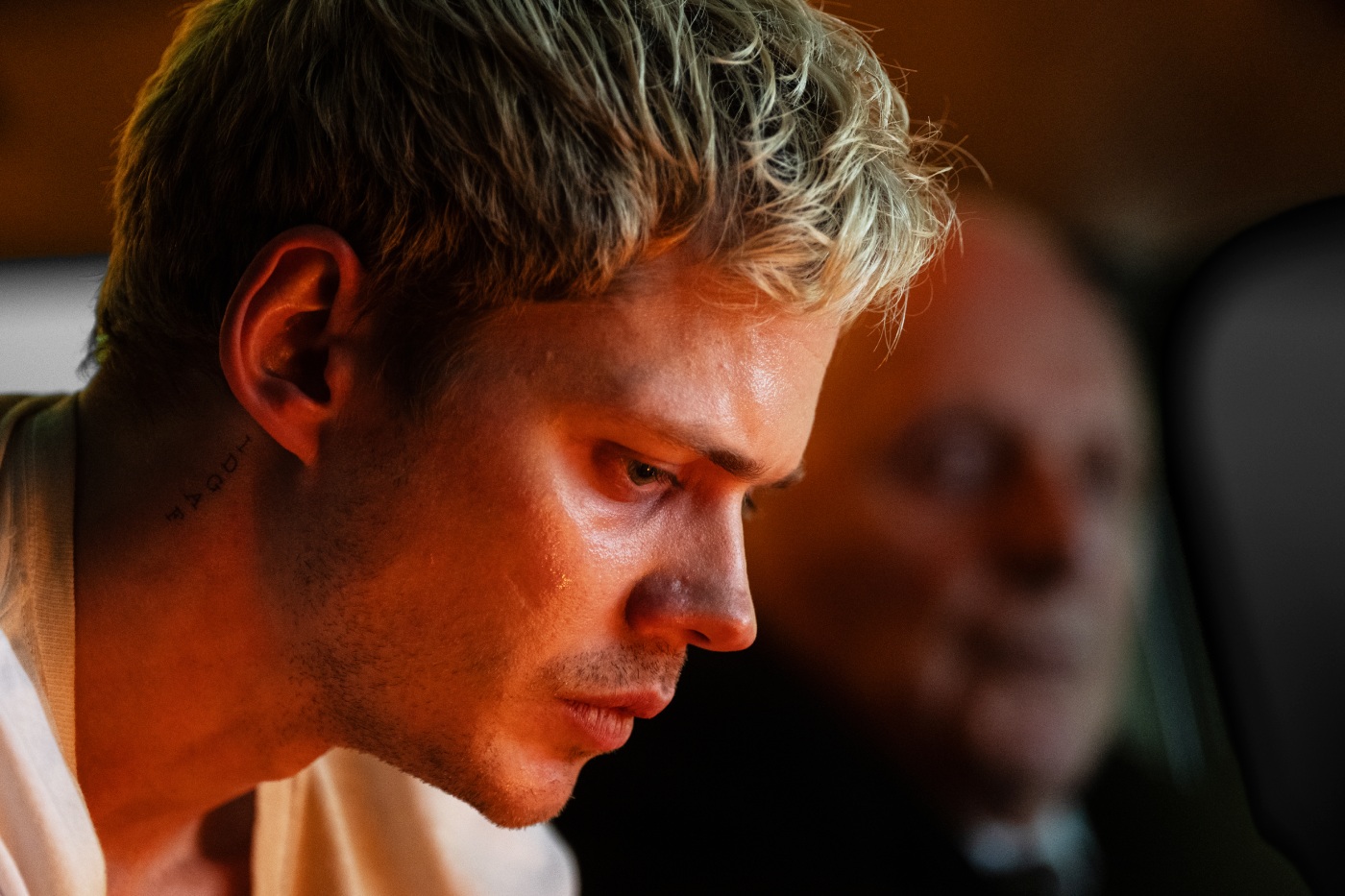Entertainment
Eric McCormack of ‘Will & Grace’ and wife Janet Leigh Holden are headed for divorce

Eric McCormack, star of the sitcom “Will & Grace,” and his wife, Janet Leigh Holden, are headed for divorce after 26 years of marriage.
Holden, 69, filed for divorce from McCormack, 60, last week in Los Angeles County Superior Court, citing the usual “irreconcilable differences,” according to the petition for dissolution obtained by The Times. The pair married on Aug. 3, 1997, and have one child together, Finnigan Holden McCormack, 21.
Representatives for Holden and Eric McCormack did not immediately respond to The Times’ requests for comment.
McCormack, who recently appeared in the Hulu series “The Other Black Girl,” first met Holden in 1994 on the set of the CBS TV series “Lonesome Dove,” which had Holden as an assistant director and McCormack as an actor. He described her as “different” from other women in the industry: “She wore jeans, drove a pick-up truck.”
They kept their affair a secret while shooting the series, McCormack said in an essay he penned for the Guardian in 2007.
“At first she wasn’t too keen,” he wrote. “She knew actors are a lot of work: it would be like taking your work home with you. But I managed to convince her. We had a secret affair the first season. I mean, dating crew! Actually, it was much worse for her, because she wasn’t supposed to give any of the actors preferential treatment.”
The pair married in 1997, five months after McCormack was cast in NBC’s “Will & Grace” as Will Truman, a gay lawyer who is best friends with straight interior designer Grace Adler, played by Debra Messing. The show ran until 2006 and had a revival for several seasons between 2017 and 2020.
“I think I was very lucky that I didn’t get well-known until my early thirties,” McCormack wrote, crediting Holden. “If it had happened when I was younger, you might have seen me falling out of nightclubs. I think I conducted myself as a much better human being because I was already married when all that came along.”

Movie Reviews
A Minecraft Movie (2025) – Movie Review

A Minecraft Movie, 2025.
Directed by Jared Hess.
Starring Jason Momoa, Jack Black, Danielle Brooks, Emma Myers, Sebastian Hansen, Jennifer Coolidge, Rachel House, Matt Berry, Kate McKinnon, Jemaine Clement, Valkyrae, Jared Hess, and Jens Bergensten.
SYNOPSIS:
Four misfits are suddenly pulled through a mysterious portal into a bizarre, cubic wonderland that thrives on imagination. To get back home, they’ll have to master this world while embarking on a quest with an unexpected, expert crafter.

Sometime after siblings Henry (Sebastian Hansen) and Natalie (Emma Myers) inadvertently discover the Overworld, where everything from buildings to environments to animals to food to other random objects are block-shaped, the former uses his child genius creativity to instantly start building elaborate constructions, as one does in the mostly plotless, sandbox video game Minecraft, but his sister struggles. She criticizes him for being a regular screwup in the real world (a heat-of-the-moment outburst she immediately regrets) while proclaiming that none of this makes any sense. Her character practically feels like a vessel for those of us coming into director Jared Hess’ A Minecraft Movie with minimal exposure.
However, despite never having played the game, I know one thing through cultural osmosis: it is intended to encourage and foster creativity in children and teenagers, which Jared Hess understands. That’s not to say the movie is any good, but “getting it” is a rarity regarding video game adaptations. It’s wonderful that this is an adaptation in conversation with not only why the games are popular, but that parents (in the case of this film, a slightly older sister looking after her younger brother while still grieving the loss of their mother) wrongfully assume that it’s a waste of time and rotting their brains, failing to realize that the game is entirely built on imagination and whatever the player wants it to be.

The punishment of removing or deleting a child’s Minecraft world is admittedly an over-the-top punishment that not only refuses to engage with the game itself but also with what they are getting from the world-building experience. It’s an instant, permanent removal of something unique, most likely impossible to duplicate. Hence, the shattering feeling of losing an entire world. Sure, it’s digital, but was lovingly put together by a human.
Jared Hess unfortunately doesn’t necessarily get to do much with this, as one imagines a gun held to he and his overcrowded screenwriting team’s (Chris Bowman, Hubbel Palmer, Neil Widener, Gavin James, and Chris Galletta) heads forcing them to shove Easter eggs and references down viewers’ throats in every single CGI, green-screened to hell and back image. This is mainly done through Jack Black portraying Steve, the default avatar from the game’s original launch (in games like these, players are encouraged to customize and project their personality onto the character), which obnoxiously amounts to that star playing himself, shouting out locations, objects, and enemy types with the demented energy of someone who just got done chugging five Red Bulls and is yelling all of this into your ear at 7 AM on a Monday when your alarm for work has gone off.

Perhaps that sounds like a hypercritical complaint after acknowledging an individual’s identity is meant to be grafted onto the avatar, but Jack Black is insufferable here. This is an embarrassing use of star power, serving as nothing more than a means to get a cheap pop out of the fans, which is especially fitting terminology since there is a scene that takes place in a wrestling ring. Everyone else will likely sit there dumbfounded. Surprisingly, they won’t necessarily be confused (most items, gear, and tools are self-explanatory), but speechless at the excessive depths of fan service. At the same time, a couple of interesting characters and ideas are ignored.
Other characters include Jason Momoa’s real-world faded superstar legendary arcade gamer Garrett “The Garbage Man” Garrison, a cocky dimwit facing foreclosure on his gaming store. Through some chance interactions with Henry, he also ends up in the Overworld, hoping to find some treasures to solve his financial woes. Initially, it’s also amusing that the character is a skilled cooperative gamer who routinely messes up inside a fantasy world while failing to work together. However, like most aspects of A Minecraft Movie, this aspect is worn down and tiring.

Similarly, this is an action-packed adventure with a number of explosions on par with a Michael Bay film, except they rarely look visually exciting here since the bright nature of the world and commercial-like photography causes every image to appear fake with washed-out colors. There is strong attention to detail regarding the aesthetics and designs, but this is otherwise a hideous film; one can’t help but wonder what could have been done using more practical effects. There is no wonderment or movie magic here, with no suspension of disbelief that everyone didn’t spend several hours a day in front of a green screen. Once in a while, there is a moderately entertaining sequence, such as a chase in a minecart that runs off a special type of energy, but it’s often weightless and doesn’t pop.
Rounding out the set of main characters is Dawn, a real estate agent, settling Henry and Natalie into their new home. Struggling to pay the bills, she works numerous jobs, including one working with animals, which is handy when finding herself in the Overworld. She is also a consistently funny presence and the only one not overdoing their role into flat-out annoyance.

Together, they must search for a magical object to reopen a portal that will take them home, while aiding Steve in a war against the Nether world’s evil pig race, led by their leader, Malgosha (a voiceover performance by Rachel House). Speaking of Steve, his basic origins as a real-world person and years in the Overworld could have been an entire movie alone. Thankfully, it isn’t, because Jack Black is already irritating enough here. Still, it goes to show the lengths to which A Minecraft Movie goes in cramming in as much as possible, with zero consideration as to what it serves in the context of a narrative.
Unsurprisingly, A Minecraft Movie‘s most inspired moments involve creativity, mainly through using materials to craft wacky weapons such as a tater tot gun or bucket nunchucks. Despite Jared Hess (and maybe one of the five screenwriters) showing a fundamental understanding of the game, it’s a shame the film is predominantly concerned with fan service and abrasively loud energy from its stars that comes across as desperately begging viewers to care. It mostly chooses laziness over imagination, directly insulting everything Minecraft stands for.
Flickering Myth Rating – Film: ★ ★ / Movie: ★ ★
Robert Kojder is a member of the Chicago Film Critics Association, Critics Choice Association, and Online Film Critics Society. He is also the Flickering Myth Reviews Editor. Check here for new reviews and follow my BlueSky or Letterboxd
Entertainment
'The White Lotus': Tell us your finale theories

Checkout time is nearly here for “The White Lotus” Season 3, and based on the premiere — and the previous editions of Mike White’s dark comedy — someone will be leaving the Thai resort in a body bag when the season finale airs Sunday, April 6.
Who is it, whodunit and how? Does Gaitok really have a killer instinct? Will the messy besties’ friendship survive? What will be the most insane thing Parker Posey says as Victoria Ratliff? Does the whole Ratliff family decide to move into the Buddhist center only to be thrown out when Saxon interrupts meditation time with a very loud blender? Will Mook finally get a subplot? Will Greg/Gary ever stop being a weirdo? Is Chelsea right and bad things happen in threes? Will Rick and Frank ever come up with a plan?
We want to know your theories. Fill out the form below and tell us what you think will happen. We’ll share some of the best ones ahead of the finale.
Our team of writers will be on hand Sunday night to talk about the finale after the episode airs. And they may even answer some of your questions, so check back for updates.
Submit your theories by noon pacific on Friday, April 4, and in the meantime, catch up with all of our coverage of “The White Lotus.”
Movie Reviews
‘Locked’ movie review: Anthony Hopkins traps Bill Skarsgård in claustrophobic thriller

NOW STREAMING ON:
A down-on-his-luck father finds himself trapped in a state-of-the-art car in Locked, a (mostly) riveting thriller opening in local cinemas this weekend that was introduced by star Bill Skarsgård and Czech producer Petr Jákl at its European premiere in Prague last weekend. This high-concept, white-knuckle thriller benefits greatly from two powerhouse performances and inventive filmmaking from director David Yarovesky (Brightburn), which help keep things interesting through an underwhelming climax.
Locked stars Skarsgård as Eddie Barrish, a pitiful courier stuck between a rock and a hard place: his van is in the shop and he’s short of the repair cost to get it out, meaning he can’t make money or even pick up his young daughter Sarah (Ashley Cartwright) from school. With his last few bucks, he buys some scratch-offs at a convenience store as one last gut-shot hope.
Eddie’s down, but he’s not quite out: from his tatted neck and bright hoodie, we infer he’s something of a hustler even before he touts his street smarts and confirms a criminal record. Walking around dystopian-modern city streets, he tests car door handles for any that might have accidentally been left open, and thinks he’s scored big when he gets inside a luxury SUV.
But Eddie couldn’t be more wrong. Not only is there nothing inside the car, which was built for the film and modeled after the Land Rover Defender—Eddie can’t get out. The doors are locked and the frame impenetrable and soundproof, the windows fully tinted, and a voice coming from the in-vehicle entertainment display informs Eddie that he’s trapped.
That man behind the voice is William (Anthony Hopkins), who tells Eddie that his car has been broken into multiple times, and the police have failed him. So he’s built this SUV as a trap to teach the next thief a lesson—one that gets increasingly dangerous as Eddie runs low on food and water, and William tortures him with electric shocks and extreme climate control settings.
Locked establishes its nifty premise within the first fifteen minutes of screentime, and culminates with a masterfully-executed sequence: as Eddie crawls through the SUV and slowly comes to the realization that he’s trapped, Michael Dallatorre’s camera impossibly swirls around Skarsgård in a single unbroken take through the tight, enclosed space. Director Yarovesky pays homage to David Fincher here, who did this kind of thing in Panic Room, while playing off his lead character’s growing anxiety.
The early scenes in Locked also do a great job of establishing the urban jungle that Eddie lives in, set against a backdrop of graffiti and concrete (the location is not specified, but Locked was shot on the streets of Vancouver). There’s some genuine affection for Eddie’s street culture that recalls 80s classics like They Live; it nicely contrasts later scenes of street life viewed from William’s point of view, vagrants and junkies glimpsed from behind the tinted glass of a luxury SUV.
Locked does such a nice job of building tension early on—and Skarsgård and Hopkins create such compelling characters—that we can look past an uneventful screenplay, adapted by Michael Arlen Ross from the 2011 Argentinean film 4 x 4, written by Mariano Cohn and Gastón Duprat. Still, it would have been nice to learn more about William’s ultimate plan, or see Eddie employ more of those street smarts.
The film really only lets us down during the finale, which operates on the level of a much more traditional thriller than the battle of wits and wills that has preceded it. The screenplay wants us to be rooting for Eddie and against his captor, but it doesn’t take into account the utterly compelling and largely sympathetic performance from Hopkins, which cries out for a more nuanced conclusion.
Still, Locked is a thoroughly captivating ride for most of the ride, fueled by strong performances, stylish direction, and a gripping premise. While the finale may not fully capitalize on the psychological cat-and-mouse game that came before it, this an entirely engaging thriller that delivers enough claustrophobic tension to keep audiences hooked from start to finish.
-

 News1 week ago
News1 week agoTrump Is Trying to Gain More Power Over Elections. Is His Effort Legal?
-

 News1 week ago
News1 week agoWashington Bends to RFK Jr.’s ‘MAHA’ Agenda on Measles, Baby Formula and French Fries
-

 News1 week ago
News1 week agoCompanies Pull Back From Pride Events as Trump Targets D.E.I.
-

 World1 week ago
World1 week agoAt least six people killed in Israeli attacks on southern Syria
-

 Technology1 week ago
Technology1 week agoTrump officials planned a military strike over Signal – with a magazine editor on the line
-

 Technology1 week ago
Technology1 week agoThe FBI launched a task force to investigate Tesla attacks
-

 World1 week ago
World1 week agoNo, Norway and Sweden haven't banned digital transactions
-

 Culture1 week ago
Culture1 week agoAnalysing Jamal Musiala’s bizarre corner goal for Germany against Italy















